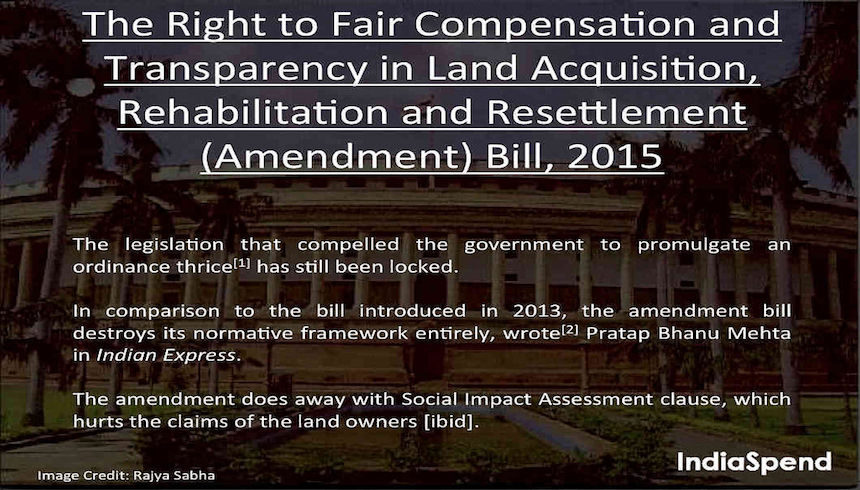Introduction to Land Acquisition Laws in India:
Land Acquisition in India means a process by which the Central or State Government acquire lands of the individual owners for the purposes of industrialisation, development or infrastructure facilities by compensating them in return for the losses incurred by them. Land is specifically defined as ‘land includes benefits to arise out of land, and things attached to the earth or permanently fastened to anything attached to the earth.’
Until 2013, the Land Acquisition Act 1894 governed the land acquisition process in India, which was introduced in the British era. The Right to Fair Compensation and Transparency in Land Acquisition, Rehabilitation and Resettlement Act, 2013, replaced the 1894 Act. The Act tries to reduce some social problems by bringing about transparency in the acquisition process, provides fair compensation and rehabilitation to those affected as even though property is not a fundamental right anymore with the Forty Fourth Amendment Act of 1978, it is still is very much a legal right and the owners deserve to be compensated according to the market value of the property during the time of acquisition.
The bill was introduced in the Lok Sabha on 7thSeptember 2011, was passed by both the houses in September, 2013, received the President’s assent on 27 September 2013 and came into force on 1st January, 2014.
With the Modi Government coming to power in 2014, it decided to bring in certain amendments in the 2013 Act through an ordinance passed on 31st December 2014. These amendments became an apple of discord due to the nature of changes it made to the Act. They are:
- Removal of consent and social impact assessment- under the UPA led Act, land could be acquired with 70% of land owners’ consent for public-private partnership programmes and 80% of land owner’ consent for private entities. However, the NDA made an exemption as to the consent and assessment for five purposes – Industrial corridors, Public Private Partnership projects, Rural Infrastructure, Affordable housing and Defense.
- The UPA led Act provided that, if the land is unutilized for 5 years then it would be returned to the land owner but the NDA ordinance provided that land will be returned if it unutilized for 5 years or any period specified during the time of setting up of project.
- Earlier, any private company could acquire land, now ‘private company’ is replaced with ‘private entity’. A private entity is an entity other than a government entity, and could include a proprietorship, partnership, company, corporation, non-profit organisation, or other entity under any other law.
- Under the new law, government officials cannot be prosecuted if they commit an offence during the process of acquisition.
- 13 legislations that were previously exempted are brought under the purview of the Act in the compensation, rehabilitation and resettlement provisions. This is however, beneficial as it brings about a uniform policy as to compensation and rehabilitation, which was absent earlier. With this they try to balance out the provisions of the ordinance as this is deemed to be ‘pro-farmer.’
- Coal Bearing Areas Acquisition and Development Act 1957, the National Highways Act 1956, Land Acquisition (Mines) Act 1885, Atomic Energy Act 1962, the Indian Tramways Act 1886, the Railways Act 1989, the Ancient Monuments and Archaeological Sites and Remains Act 1958, the Petroleum and Minerals Pipelines (Acquisition of Right of User in Land) Act 1962 and the Damodar Valley Corporation Act 1948. The Electricity Act 2003, Requisitioning and Acquisition of Immovable Property Act 1952, the Resettlement of Displaced Persons (Land Acquisition) Act 1948 and the Metro Railways (Construction of Works) Act 1978 are the 13 legislation included under the purview of the Act.
These amendments are deemed to be against the farmer and adjudged to be the cause for a lot of social problems in India.
Reason for amendment in Land Acquisition Law:
The reason why Modi Government is pushing for such amendments is because from the beginning Modi has been campaigning thrivingly for the ‘Make In India’ initiative to promote manufacturing in India itself but acquiring lands has become a problem. Industries cannot buy from the farmers directly as the records of the documents cannot be easily verified. Due to these hurdles, firms have been dropping their investment plans.
On the flipside, however, the land owners’ have not been rehabilitated under the Act after acquiring their property. The draft of the government’s National Policy for Rehabilitation states that a figure around 75% of the displaced people since 1951 are still awaiting rehabilitation which demonstrates the pathetic situation of the land owners and acts as a pre-cursor of how much more worse this social problem could get in future.
Subsequently, the Government on July 24th to endorse the ordinance, introduced an amendment bill, which was passed by the Lok Sabha, but the same is still lying in the Rajya Sabha. On 30th May, 2015, the President promulgated the amendment ordinance for the third time. Congress has strongly opposed this amendment from the beginning blaming NDA Government of being a ‘suit-boot’ sarkar and being oblivious to the needs and benefits of the farmers of the country. Other parties JD(U), AAP etc also have strongly raised their voices against the bill.
In fact escalating problems for the Government, its own allies have opposed the bill. There has been news that the Government might make changes to the amendment in order to garner support of the opposition parties and if the bill is not passed by the Rajya Sabha, it might call for joint session but with its own allies against it, it seems like a hercules task for the BJP to get their bill passed.
Recently, in pursuance of this bill, a meeting was called in New Delhi on Wednesday in which Chief Ministers of 14 States were missing. In the second meeting nine states ruled by the Congress opposed the bill except Bihar Chief Minister, Nitish Kumar taking everyone by surprise. The Prime Minister was of the opinion that the land acquisition bill needs the consent of central and state governments as the delay is causing hurdles in programmes relating to rural empowerment like establishment of schools, colleges, hospitals, roads, rivers which is provided for by the new Act which not was not present in the previous legislation.
Latest on Land Acquisition Bill:
Finally, the UPA seems to have won the battle on the Land Acquisition Bill after BJP drops almost all the amendments it envisaged to bring through its bill. In effect, restoring the provisions of the 2013 Act which was passed during the UPA tenure.
With this, the Congress finally won a point against its arch rival BJP. Congress Vice President, also went and ahead and tweeted – ‘The Modi Govt will soon understand that truth cannot be silenced.The ppl of India&Congress Party have shown this in case of land bill.‘ On the other hand, BJP is treating it as a part of their strategy to resume Parliament proceedings as the bill was one of the major hurdles.
Amendments like introducing ‘private entity’ instead of ‘private company’ , the five exemptions that NDA had sought under Chapter 3A of the Act have been done away with. the politically vexed consent and Social Impact Assessment (SIA) clauses have also ben restored. This was possible due to leading BJP members who joined the parliamentary committee in recommending that the key amendments to the land bill be dropped. So, there have been consensus on a total of 12 clauses out of the 15. The remaining three are retrospective effect of the bill. The clause which mentions that if the land is unutilised for 5 years, it shall be returned to the original owner, and if compensation is deemed to have been paid, compensation is kept in dedicated account.
Well, seems like Government has realised that it doesn’t have the required majority in the Rajya Sabha. Also, we must thank the BJP allies that stood against them in bringing about this positive outcome. Hopefully, the Government has realised how lopsided their proposed land acquisition amendments were and the onerous position in which the farmers were put due to them.
Picture Courtesy: Flickr








There's 1 Comment